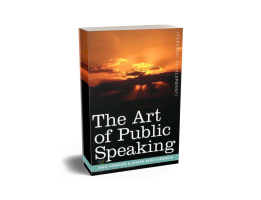
2015 July
By: Dale Carnegie (1888-1955)
The principles of public speaking written by Dale Carnegie decades ago in this book are timeless. They are just as effective in working a crowd in today's society as they were back then. He delves into ways of commanding and charming an audience with the right energy, tone of voice, pitch, pronunciation and vocabulary. Armed with the principles highlighted in this book, you can do more than convey a message to a group of people, you can move them.
Carnegie gives useful advice and hints on public speaking stating that when you have something to say, are adequately prepared and have mastered an audience then public speaking success is eminent. He delivers a topic by topic approach offering solutions to common public speaking problems. Moreover, each chapter features practice questions and exercises to help the reader understand the subject better.
- 00 - Things to Think of First - A Foreword
- 01 - Acquiring Confidence Before an Audience
- 02 - The Sin of Monotony
- 03 - Efficiency Through Emphasis And Subordination
- 04 - Efficiency Through Change of Pitch
- 05 - Efficiency through Change of Pace
- 06 - Pause and Power
- 07 - Efficiency Through Inflection
- 08 - Concentration in Delivery
- 09 - Force
- 10 - Feeling and Enthusiasm
- 11 - Fluency through Preparation
- 12 - The Voice
- 13 - Voice Charm
- 14 - Distinctness And Precision Of Utterance
- 15 - The Truth about Gesture
- 16 - Methods Of Delivery
- 17 - Thought and Reserve Power
- 18 - Subject and Preparation
- 19 - Influencing by Exposition
- 20 - Influencing by Description
- 21 - Influencing by Narration
- 22 - Influencing by Suggestion
- 23 - Influencing by Argument
- 24 - Influencing by Persuasion
- 25 - Influencing the Crowd
- 26 - Riding the Winged Horse
- 27 - Growing a Vocabulary
- 28 - Memory Training
- 29 - Right Thinking and Personality
- 30 - After-Dinner and Other Occasional Speaking
- 31 - Making Conversation ERffective
- 32 - App. A: Fifty Questions for Debate
- 33 - App. B: Thirty Themes for Speeches
- 34 - App. C: Suggestive Subjects for Speeches
- 35 - App. D: Speeches for Study and Practice - Newell Dwight Hillis
- 36 - App. D: Speeches for Study and Practice - Henry Watterson
- 37 - App. D: Speeches for Study and Practice - John Morley
- 38 - App. D: Speeches for Study and Practice - Robert Toombs
- 39 - App. D: Speeches for Study and Practice - Theodore Roosevelt
- 40 - App. D: Speeches for Study and Practice - Alton B. Parker
- 41 - App. D: Speeches for Study and Practice - John W. Wescott
- 42 - App. D: Speeches for Study and Practice - Henry W. Grady
- 43 - App. D: Speeches for Study and Practice - William McKinley
- 44 - App. D: Speeches for Study and Practice - John Hay
- 45 - App. D: Speeches for Study and Practice - William Jennings Bryan
- 46 - App. D: Speeches for Study and Practice - Rufus Choate
- 47 - App. D: Speeches for Study and Practice - Albert J. Beveridge
- 48 - App. D: Speeches for Study and Practice - Russell Conwel
- 49 - App. D: Speeches for Study and Practice - Victor Hugo
